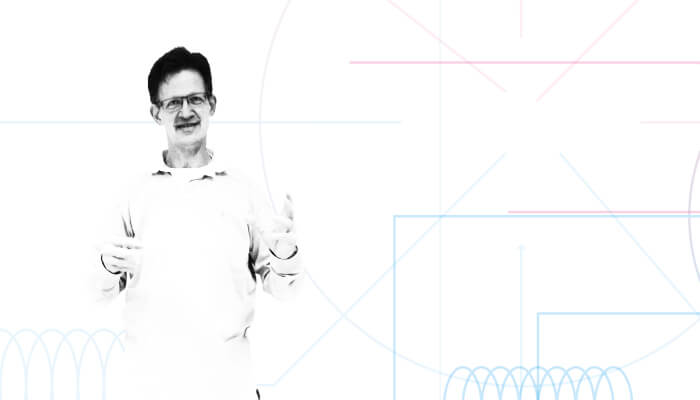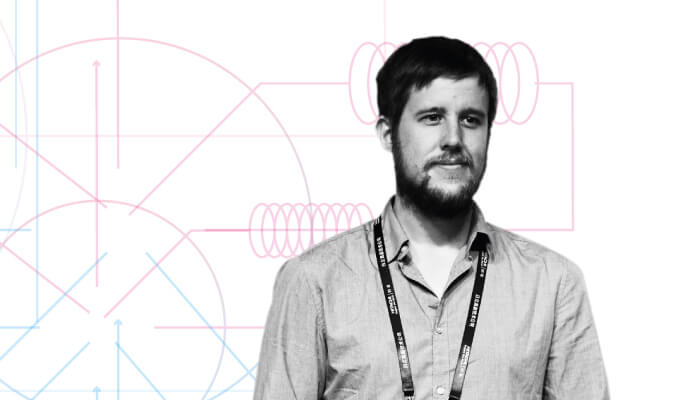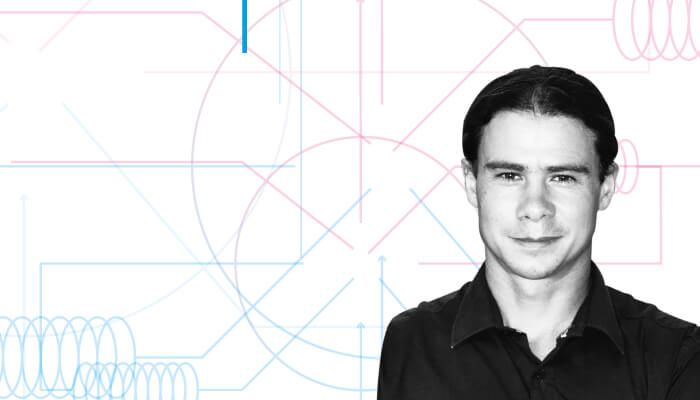Though the concept has been around since the 1970s, it’s only recently that 2D-LC has become a realistic prospect for more routine applications. Ahead of HPLC 2019 in Milan, we gathered seven gurus to discuss the challenges and promise of delving into the second dimension. A round-table discussion is presented below – but you can also read the viewpoints of Isabelle François, Monika Dittmann, and Stephan Buckenmaier in A Turning Tide and Change on the Horizon.
Peter Schoenmakers, Professor and Scientific Director, Van ‘t Hoff Institute for Molecular Sciences, University of Amsterdam, the Netherlands.

Bob Pirok, Analytical Chemistry Group, Van ‘t Hoff Institute for Molecular, Sciences, University of Amsterdam, the Netherlands.

Koen Sandra, Scientific Director, Research Institute for Chromatography, Kortrijk, Belgium; co-founder and R&D Director anaRIC biologics, Ghent, Belgium, and Visiting Professor at Ghent University, Belgium.

André de Villiers, Department of Chemistry & Polymer Science, Stellenbosch University, South Africa.

Bob: Together with Dwight Stoll’s group from Gustavus Adolphus College, we recently began compiling a free and searchable database of all existing applications of two-dimensional liquid chromatography (2D-LC; www.2DLCdatabase.com). Looking at the papers in this list, you can see the incremental stages of development unfold. Though the essential concepts of 2D-LC were introduced as early as the 1970s by Erni and Frei (1) and comprehensive 2D-LC (LC×LC) as we know it today was described in 1990 by Jorgenson and Bushey (2), it wasn’t until the 21st century that development really started to pick up.
Landmark papers introducing sample dimensionality (3) and statistical overlap theory (4) convinced many scientists in academia that multidimensional chromatography was the way to obtain the vast peak capacities required for very complex samples. At the same time, an increasing number of groups started to combine 1D-LC systems for an array of applications, such as food, metabolites and pharmaceuticals.
Koen: Basic multidimensional separations (heart-cutting) have long been used to boost resolution. The breakthrough for comprehensive multidimensionality in both gas chromatography (GC) and LC was the development of high-speed separations. The latter was a tougher technical challenge (smaller particles, higher pressures), which explains the much earlier commercialization of GC×GC compared with LC×LC. The first commercial LC×LC instruments were only introduced in the past few years and this has paved the way for the full exploration of 2D-LC.
André: I believe two crucial steps have paved the way for the increasing adoption of multidimensional techniques. First, the advent of a coherent theoretical framework for multidimensional LC separations, and particularly LC×LC. Much of the theory has long been known from the work of the pioneers of the field and from GC×GC – the more established older brother of LC×LC. However, these principles had to be adapted to the unique characteristics of LC, including the need to quantify orthogonality, mobile phase compatibility issues between often-unrelated separation, and instrumental contributions to band broadening.
The second piece of the puzzle has been the availability of dedicated, quality instrumentation enabling straightforward, automated 2D-LC operation. Indeed, the column and instrumental hardware required to perform the very fast, high-efficiency separations demanded by modern LC×LC were not (commercially) available 20 years ago.
Bob: Although work during the 1990s and 2000s established the potential of 2D-LC, its greater peak capacities came at serious cost: complex method development, reduced detection sensitivity and solvent-compatibility issues – all of which forced many researchers to combine their LC systems off-line. Meanwhile, LC and mass spectrometry (MS) established an extremely successful marriage, and peak capacity was improved by superficially-porous particle technology and tremendously powerful ultra-high-performance LC (UHPLC) systems, delaying the need for multidimensional LC.
André: Much of the initial research was performed on home-built systems; the introduction of commercial, dedicated high-performance instrumentation has greatly extended the accessibility of multidimensional LC. One development of note is automated (multiple) heart-cutting instrumentation and dedicated instrumental control software. This technology is particularly promising in industries where complementary selectivity is needed to provide more information on particular sample components or fractions; for example, impurity profiling in the pharmaceutical industry.
Koen: The introduction of commercial instruments and accompanying data acquisition and data analysis software will indeed result in many new applications. Of equal importance is the availability of various interfaces that allow the scientists to select the mode best tailored towards their needs, whether LC×LC, heart-cutting (LC-LC), multiple heart-cutting (mLC-LC) or high-resolution sampling.
As André notes, the two last techniques are nowadays intensively applied in pharmaceutical analysis. Recently, interfaces have been designed to allow active solvent modulation (ASM) to facilitate transfer from first to second dimension – particularly interesting in heart-cutting and multiple heart-cutting modes.
Bob: I agree with Koen that the introduction of active modulation – in which the composition of the first-dimension effluent fraction is changed prior to injection into the second dimension – has been a major step forward. Several active-modulation techniques have been introduced, including the ASM mentioned by Koen, and stationary phase-assisted modulation (SPAM). Both techniques dramatically improve detection sensitivity, reduce analysis time and enhance applicability. For example, SPAM allows salts or organic solvents from a first-dimension ion-exchange separation to be removed prior to an aqueous reverse-phase LC separation using MS. That said, these modulators also increase the complexity of the already challenging method development for 2D-LC, and much research is devoted to solving this issue, including extensive use of computer-aided development.
Taking into account all of the new developments, I think it is safe to say that there has been a major shift in how multidimensional LC is perceived. More attention to robustness and method development strategies is still required, but 2D-LC is no longer a technique that suffers from solvent-compatibility, cumbersome method development and reduced detection sensitivity. Instead, it is a rapidly maturing technique, with clear applications in academia and industry.
Peter: The first decade of the 21st century saw the first push for 2D-LC from industry. The characterization of complex polymers that featured multiple independent distributions was an obvious fit for LC×LC because of the low sample dimensionality (resulting in structured LC×LC chromatograms) and the difficulty of applying MS for characterizing high-molecular-weight polymers.
Convinced by the need for multidimensional LC, Waters and Agilent introduced the first dedicated 2D-LC systems, making the technology more accessible to industry. We see increased availability reflected in a steep increase in the number of publications per year concerning the implementation of 2D-LC.
Koen: All fields in which both high peak capacity and high selectivity are needed could benefit from multidimensional LC, including:
- Pharmaceuticals
- Biopharmaceuticals
- Natural products
- Omics (metabolomics, lipidomics, proteomics)
- Polymers (including surfactants)
- Petrochemicals
The major driver to apply 2D-LC methods to date has been to maximize peak capacity to tackle complex samples but, as the field develops, other benefits of 2D-LC are becoming apparent, including the ability to obtain orthogonal information and make separations compatible with MS.
Bob: MS and LC-MS are immensely important analytical tools. When more quantitative information is required, the chromatography aspect is more important; if more components need to be characterized, we cannot rely so heavily on MS.
Koen: It is not logical to consider MS as a competitor – although I think that chromatographers often look at it that way. Chromatography and MS go hand-in-hand, and the majority of chromatographic systems in our lab are combined with MS. Apart from being a detector, we should not forget that MS adds resolution and so can be considered as an extra separation dimension. And the same is true for ion mobility.
André: Nowadays, MS is unarguably the most important detector in chromatography – and that is true for multidimensional LC too. Aside from the evident power of MS for identification purposes, it is especially important for the analysis of highly complex samples – the main application area of multidimensional LC – and the number of papers on multidimensional LC-MS is increasing steadily. Commercial software enabling 2D-LC-MS data analysis is available, albeit without some of the most advanced features offered for 1D-LC-MS data. However, not all MS instruments are suitable for hyphenation to multidimensional LC. For LC×LC in particular, high acquisition speeds are essential, and depending on the type of instrument, certain sacrifices have to be accepted.
Koen: Of course, there is no single analytical technique that can provide the answer to all research questions. However, we do have high hopes for the superb resolution offered by ion mobility spectrometry (IMS), which has gone from a resolving power of 20–40 to greater than 200. In combination with 2D-LC and high-resolution mass analyzers, a new era of resolving power is upon us.
André: I too am excited about the incorporation of IMS in multidimensional analyses. IMS is perfectly compatible as an additional separation step of gas-phase ions between chromatographic separations and MS. Realistically, I think that IMS will rarely provide separation of isobaric species -which cannot be distinguished by MS - which also cannot be separated by multidimensional LC or LC×LC. Rather, the principal benefits of IMS in multidimensional LC are that the arrival time of ions can be used as an additional identification criterion, and mass spectral data can be filtered according to arrival time to improve the quality of MS data.
Peter: I actually disagree on this point. From the perspective of MS, ion-mobility has a lot (of selectivity) to add; from the perspective of LC-MS, I believe IMS adds very little, because the same selectivity can be more easily obtained (and exceeded) in the liquid phase.
André: To gain more widespread acceptance by industry and academia we need to show that multidimensional LC can be applied to real-world analytical problems. There are many applications that admirably demonstrate the utility of the technique, including pharmaceutical analysis (for both small molecules and biopharmaceuticals), natural product analysis, polymer analysis, and the ‘omics’ fields (metabolomics, lipidomics and, especially, proteomics).
Koen: These are exciting times for scientists with an interest in 2D-LC. We are particularly looking forward to witnessing the developments in (bio)pharmaceutical analysis, where 2D-LC currently has the greatest momentum. Five years ago, there were often only a few LC×LC presentations on (bio)pharmaceutical applications; nowadays, these talks and posters are dominating the conferences. 2D-LC can be applied throughout all stages of drug development and the first validated methods have already become reality.
From a biopharmaceutical perspective, LC×LC has shown great value in detecting post-translational modifications in monoclonal antibodies (mAbs), identifying drug conjugation sites, assessing comparability between innovator mAbs and biosimilars, and so on. In heart-cutting or multiple heart-cutting mode, the technique has been used to make the incompatible compatible. As an example, mAbs and other protein therapeutics are often separated by techniques that make use of non-volatile salts, such as size-exclusion chromatography (SEC), ion exchange chromatography (IEX), hydrophobic interaction chromatography (HIC), and affinity chromatography. By combining these separation modes with reversed-phase liquid chromatography (RPLC) in front of a mass spectrometer, MS spectra can be obtained for SEC, IEX or HIC peaks, since the second RPLC dimension takes care of the desalting.
2D-LC, and recently even 3D-LC, have also been used to obtain complimentary information. By combining Protein A affinity chromatography with IEX, SEC and/or LC-MS one can simultaneously assess mAb titer as well as important structural characteristics, such as aggregation, fragmentation, and post-translational modifications, directly from cell culture supernatants.
Koen: There are some technological improvements that would be welcome. Depending on how 2D-LC is performed, the technique can suffer from issues, such as flow/mobile-phase incompatibilities, sensitivity, reproducibility, and immature data analysis software.
The other main challenge? Education! Scientists need to understand when to use the technology – as we’ve seen with SFC, if they apply 2D-LC when it isn’t necessary, disappointment will follow.
André: The challenges are major and often underestimated. Firstly, despite significant advances in instrumentation, it is becoming increasingly evident that loss in performance, especially extra-column contributions to zone broadening in the second dimension of LC×LC, remains problematic. The very fast and efficient separations attainable on the latest generation of columns are often severely compromised by the volume of tubing, detectors, and even connections. Plus, the extra-column volume contribution of most conventional MS instruments inevitably leads to more band broadening; in addition to insufficient data acquisition rates, this is one of the main reasons that LC×LC-MS data are currently of much lower quality than data from LC×LC-UV.
Secondly, modulation is a critical step and, despite influential developments (SPAM, ASM and even evaporative modulation interfaces) there is no universal solution for all combinations of separation modes. Indeed, one of the main drawbacks of multidimensional LC is the severe dilution experienced by analyte zones in two dimensions, which is exacerbated by the need to use narrow-bore columns in the first dimension and wide-bore columns in the second – a problem that that could be solved by effective modulation.
Finally, an important stumbling block on the path to widespread acceptance is the fact that the technique – method development and optimization in particular – is extremely
complex. Important progress has been made in method development by Peter’s group and others, but more should be done to make the technique accessible to non-experts.
Peter: I agree. The hardware has been extensively developed over the past decade, but – especially for LC×LC – the method development is still too lengthy and thus costly. Academic setups mostly rely on the use of trapping cartridges for SPAM. Though incredibly effective at resolving the detection-sensitivity and solvent-incompatibility issues that held 2D-LC back for a long time, they are not very robust.
Peter: Though ASM appears to be limited to separation systems using RPLC in the second dimension, the technique is simple and reliable. And recent reviews note that the majority of multidimensional systems do use RPLC. Combined with heartcut 2D-LC – a technique which is relatively straightforward to use for the operator with experience in 1D-LC – this should prove a powerful tool in the analytical lab.
I expect column manufacturing techniques will change dramatically with the emergence of 3D-printing techniques – perhaps this will give rise to the next big leap in 2D-LC technology.
André: I think the priorities for the future of the field are:
- Improved instrumentation, including high-speed, low-volume MS detectors.
- New and improved modulation strategies.
- Rapid increase in the (realistic) applications of the technique to solve real-life problems.
- More widespread understanding of the theoretical and practical aspects of multidimensional LC, and appreciation for the strengths and limitations of the technique.
Despite the remaining challenges, I suspect LC×LC will soon become a routine method for highly complex samples, just like GC×GC. And, also just like GC×GC, the next hurdle will be extracting the relevant information from such highly complex data sets. In this endeavor, chemometricians and software developers will have an important part to play, as many of the established data analysis packages for 1D-LC(-IM)-MS data are not suitable for higher-dimensional data.
For me, research in 2D-LC has been a highly rewarding experience, and I look forward to whatever the future holds with excitement and anticipation.
Koen: In the near-future, I believe we will see multidimensional LC being widely used in (bio)pharma R&D labs and starting to enter QC labs. I think we can expect to see a number of developments:
- Many software advances to facilitate method development and data analysis, and further research into overcoming incompatibilities between dimensions; for example, using ASM.
- Increasing use of 3D-LC (in space/time), which will put extra pressure on method development, detection and data analysis.
- Miniaturization and other instrumental advances to cope with the sensitivity issues in LC×LC.
- Incorporation of reactors in multidimensional set ups.
In biopharmaceutical analysis, peptide mapping is required to identify first-dimension peaks. When peaks are collected off-line, peptides can easily be generated by adding trypsin but in an online set-up this is more complex. Several papers have described online digestions in multidimensional set-ups.
During a panel discussion at a recent biopharmaceutical analysis conference, an attendee representing a pharmaceutical company asked: “People have been talking about 2D-LC for so many years, when will it finally become applicable in the biopharmaceutical industry?” My response: “The time has come.”
References
- F Erni, RW Frei, J Chromatogr A, 149, 561-569 (1978). DOI: 10.1016/S0021-9673(00)81011-0
- MM Bushey, JW Jorgenson, Anal Chem (1990) 62, 161-167. DOI: 10.1021/ac00209a002
- JC Giddings, J Chromatogr A, 703, 3 (1995). DOI: 10.1016/0021-9673(95)00249-M
- JM Davis, JC Giddings, Anal Chem, 55, 418–424 (1983). DOI: 10.1021/ac00254a003




